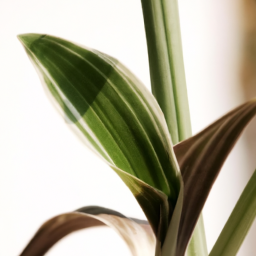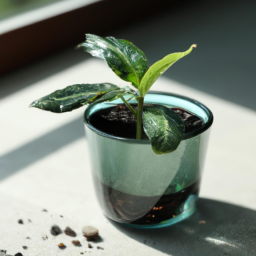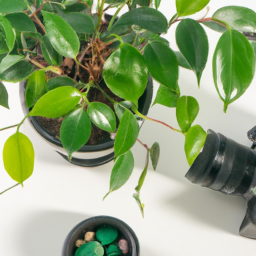
Are you torn between filling your living space with lush greenery or creating a vibrant garden outside? The debate of Indoor Plants vs Outdoor Plants is a common dilemma for plant enthusiasts. Both options have their own unique benefits and challenges, making it important to weigh the pros and cons before making a decision. In this blog post, we will explore the differences between indoor and outdoor plants, helping you make the best choice for your home or garden. Let’s dive in and discover which option is right for you!
Benefits of Indoor Plants for Home Decor and Air Quality
Enhancing Home Decor
Indoor plants are a fantastic way to enhance the decor of your home. They add a touch of nature and greenery to any space, making it feel more inviting and cozy. Whether you have a modern, minimalist style or prefer a more bohemian look, there are indoor plants to suit every taste and aesthetic.
In addition to adding visual interest, indoor plants can also help to create a sense of tranquility and relaxation in your home. Studies have shown that being around plants can reduce stress and anxiety, making them the perfect addition to any room where you want to unwind and de-stress.
When choosing indoor plants for your home, consider the size and shape of the plant, as well as its care requirements. Some plants, like succulents and air plants, are low-maintenance and perfect for beginners, while others, like fiddle leaf figs and monsteras, require more attention and care.
Improving Air Quality
One of the biggest benefits of having indoor plants in your home is their ability to improve air quality. Plants absorb carbon dioxide and release oxygen through photosynthesis, helping to purify the air and create a healthier indoor environment.
In addition to producing oxygen, indoor plants can also remove harmful toxins from the air, such as formaldehyde, benzene, and trichloroethylene. This can help to reduce indoor air pollution and improve respiratory health, particularly for those who suffer from asthma or allergies.
Some of the best plants for improving air quality include spider plants, peace lilies, and snake plants. These plants are known for their ability to filter out toxins and pollutants, making them a great choice for any room in your home.
Tips for Caring for Indoor Plants
Taking care of indoor plants requires a bit of time and effort, but the benefits are well worth it. To ensure your plants thrive, it’s important to provide them with the right amount of light, water, and nutrients.
When choosing a spot for your indoor plants, consider the amount of natural light available. Most plants prefer bright, indirect light, so placing them near a window or in a well-lit room is ideal. If your plants aren’t getting enough light, consider supplementing with a grow light to help them thrive.
In terms of watering, it’s important to strike the right balance. Overwatering can lead to root rot, while underwatering can cause your plants to wilt and die. To prevent this, water your plants when the top inch of soil feels dry to the touch, and be sure to use a well-draining potting mix to prevent waterlogged roots.
Finally, don’t forget to fertilize your plants regularly to help them grow and thrive. Choose a balanced, water-soluble fertilizer and follow the instructions on the package for best results. With a little bit of care and attention, your indoor plants will reward you with their beauty and health benefits for years to come.

Tips for Choosing the Right Outdoor Plants for Your Garden
Understanding the Difference Between Indoor and Outdoor Plants
When it comes to choosing the right plants for your garden, it’s important to understand the differences between indoor and outdoor plants. Indoor plants are typically grown inside the home or in a greenhouse, where they are protected from the elements. They require specific care in terms of light, temperature, and humidity. Outdoor plants, on the other hand, are meant to be grown outside in the garden, where they are exposed to natural sunlight, rain, and wind. They are generally more resilient and able to withstand fluctuations in weather conditions.
When selecting outdoor plants for your garden, it’s important to consider the climate in your area. Some plants thrive in hot, sunny conditions, while others prefer cooler, shadier environments. It’s also important to consider the soil type in your garden, as some plants require well-drained soil, while others prefer moist, rich soil. By doing a little research and understanding the specific needs of the plants you are considering, you can ensure that they will thrive in your outdoor space.
Choosing Plants Based on Sunlight Requirements
One of the most important factors to consider when choosing outdoor plants for your garden is the amount of sunlight they require. Some plants, such as roses and tomatoes, thrive in full sun and require at least 6-8 hours of direct sunlight per day. Other plants, such as hostas and ferns, prefer partial shade and can tolerate 3-6 hours of sunlight per day. It’s important to observe the sunlight patterns in your garden and choose plants that are suitable for the amount of sunlight they will receive.
In addition to sunlight requirements, it’s also important to consider the microclimates in your garden. Some areas may be hotter or cooler than others, or may be more exposed to wind or rain. By choosing plants that are well-suited to the specific conditions in your garden, you can ensure that they will thrive and flourish. Consider creating different planting zones in your garden based on sunlight and microclimate conditions, and choose plants that are appropriate for each area.
Considering Maintenance and Care Requirements
When choosing outdoor plants for your garden, it’s important to consider the maintenance and care requirements of each plant. Some plants, such as roses and hydrangeas, require regular pruning and fertilizing to thrive. Others, such as succulents and ornamental grasses, are low-maintenance and require little care once established. Consider your own gardening style and the amount of time you are willing to dedicate to caring for your plants when choosing which ones to include in your garden.
It’s also important to consider the size and growth habit of the plants you choose. Some plants, such as shrubs and trees, may grow quite large over time and require regular pruning to keep them in check. Others, such as groundcovers and perennials, may spread quickly and require regular dividing to prevent overcrowding. By considering the maintenance and care requirements of each plant before adding it to your garden, you can ensure that your outdoor space remains beautiful and healthy for years to come.

Comparison of Maintenance Requirements for Indoor and Outdoor Plants
Understanding the Differences in Maintenance Needs
When it comes to caring for plants, whether they are indoors or outdoors, there are some key differences in maintenance requirements that you need to be aware of. Indoor plants are typically more sensitive to changes in environment, such as temperature and humidity, while outdoor plants are exposed to the elements and may require more frequent watering and fertilizing. Understanding these differences will help you provide the best care for your plants.
Indoor plants generally require less maintenance than outdoor plants because they are protected from harsh weather conditions and pests. However, they still need regular watering, fertilizing, and pruning to thrive. Indoor plants also benefit from being placed in a location with adequate sunlight and good air circulation. It’s important to monitor the moisture levels in the soil and adjust your watering schedule accordingly.
On the other hand, outdoor plants are exposed to a variety of environmental factors that can impact their growth and health. They may require more frequent watering during hot weather or periods of drought, as well as regular fertilizing to replenish nutrients in the soil. Outdoor plants also need to be monitored for pests and diseases, which can spread quickly in an outdoor environment.
Tips for Maintaining Indoor Plants
When caring for indoor plants, it’s important to choose the right type of plant for your home environment. Some plants thrive in low light conditions, while others require bright, indirect sunlight. Make sure to research the specific needs of each plant and provide the appropriate care.
Water indoor plants when the top inch of soil feels dry to the touch, but be careful not to overwater. Use a well-draining potting mix and ensure that the plant’s container has drainage holes to prevent root rot. Fertilize indoor plants every 4-6 weeks during the growing season to promote healthy growth.
Prune indoor plants regularly to remove dead or yellowing leaves, as well as to encourage new growth. Wipe the leaves with a damp cloth to remove dust and keep them looking healthy. Monitor your plants for signs of pests or diseases, such as yellowing leaves or sticky residue, and treat them promptly to prevent further damage.
Tips for Maintaining Outdoor Plants
Outdoor plants require regular maintenance to ensure they remain healthy and vibrant. Water outdoor plants deeply and infrequently to encourage deep root growth and drought tolerance. Mulch around the base of outdoor plants to retain moisture and suppress weeds.
Fertilize outdoor plants in the spring and summer months to provide essential nutrients for growth and flowering. Prune outdoor plants as needed to remove dead or damaged branches, as well as to shape the plant and promote air circulation. Monitor outdoor plants for pests and diseases, and treat them with organic or chemical controls as necessary.
It’s important to consider the specific needs of each plant when caring for them, whether they are indoors or outdoors. By understanding the differences in maintenance requirements and providing the appropriate care, you can help your plants thrive and beautify your living space.
Crisp Recap
Indoor plants and outdoor plants each have their own unique benefits and challenges. Indoor plants are great for adding a touch of greenery to your home or office, and they can help improve air quality by removing toxins and releasing oxygen. They are also easier to care for since they are protected from harsh weather conditions and pests. However, indoor plants require more attention to their lighting, watering, and temperature needs to thrive.
On the other hand, outdoor plants have the advantage of natural sunlight and fresh air, which can promote healthy growth and vibrant blooms. They also have more space to spread out and grow to their full potential. However, outdoor plants are more susceptible to pests, diseases, and extreme weather conditions, which can make them more challenging to maintain. Ultimately, whether you choose indoor or outdoor plants depends on your personal preference, space availability, and commitment to caring for your green companions.
Here are the top questions that we were asked:
Q1: What are the main differences between indoor plants and outdoor plants?
A1: Indoor plants are typically suited for environments with lower light levels and controlled temperatures, while outdoor plants thrive in natural sunlight and varying weather conditions.
Q2: Can I grow outdoor plants indoors?
A2: Some outdoor plants can be grown indoors, but it’s important to consider their specific sunlight and temperature requirements to ensure they thrive in an indoor environment.
Q3: Do indoor plants require different care than outdoor plants?
A3: Yes, indoor plants often require more frequent watering and occasional fertilization since they are not exposed to natural elements like rain and soil nutrients.
Q4: What are the benefits of having indoor plants over outdoor plants?
A4: Indoor plants can help improve indoor air quality, add a touch of nature to your living space, and are generally easier to maintain compared to outdoor plants.
Q5: Can I move my indoor plants outdoors during certain seasons?
A5: Yes, you can move some indoor plants outdoors during warmer seasons, but be sure to gradually acclimate them to the new environment to prevent shock and ensure they continue to thrive.
Dr. Olivia Green is a botanist with over two decades of experience in indoor plant cultivation. She holds a Ph.D. in Plant Biology and has dedicated her career to researching plant behavior in controlled environments. Dr. Green is passionate about helping plant enthusiasts master the art of indoor gardening through her extensive knowledge and practical insights.


